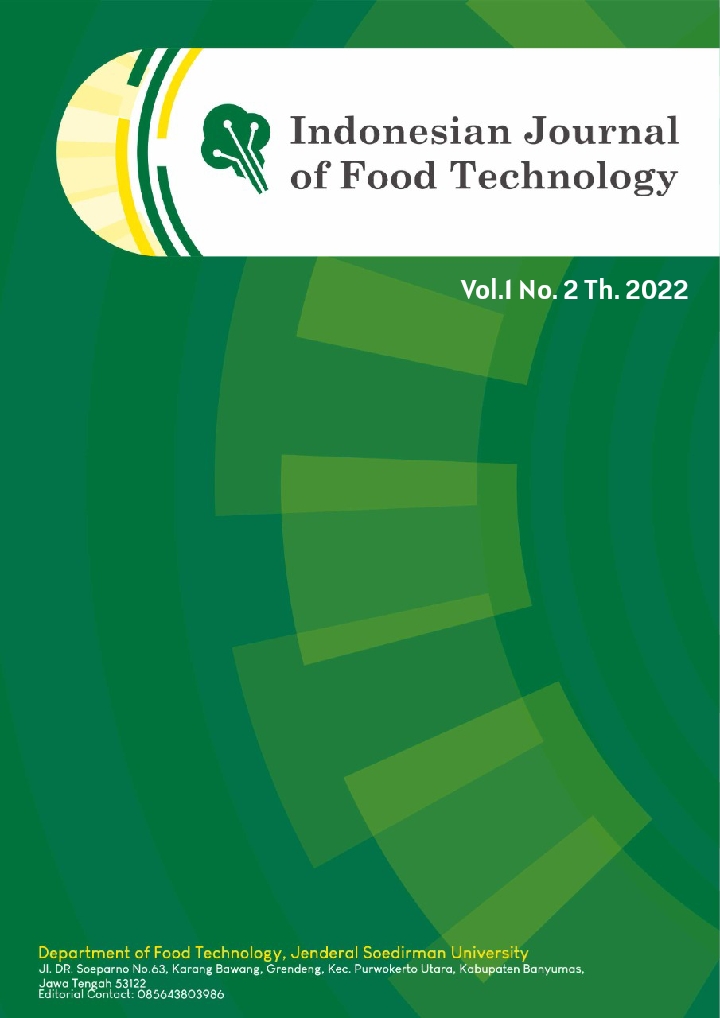The Influence of Agroclimate, Gandatapa Village, Sumbang Subdistrict on Microbial Profile, Brix Values, and Total Sugar, Naturally Spread Coconut Sap
Abstract
Temperature and relative humidity are factors that affect the microbial profile and brix value of coconut sap. High temperature and relative humidity tend to support microbial growth. On the other hand, high relative humidity will reduce the brix value and total coconut sap sugar. Therefore, it is necessary to study the relationship between agro-climatic conditions with microbial profile, brix value and total sugar in organically run coconut sap in Gandatapa Village. This research is expected to provide benefits for those who need coconut sap as a source of S. cerevisiae and as a raw material for the manufacture of brown sugar. Coconut sap samples were taken using a simple random technique. Temperature and relative humidity were recorded for each sampling. 250 ml of coconut sap was put into a sterile plastic bottle and then using an ice box, it was taken to the Agricultural Technology Laboratory for analysis. The analysis carried out included total microbes, total yeast, total bacteria, yeast percentage, brix value and total coconut sap sugar. The data were analyzed using Pearson correlation to determine the relationship and the degree of closeness. The results showed that temperature and relative humidity were positively correlated with the microbial profile of organically dissolved coconut sap. At an air temperature of 28.4oC and an air humidity of 81%, the total microbes of organically run coconut sap were 6.45 logs, the total yeast was 4.28 log cfu/ml, the total bacteria were 2.52 log cfu/ml and the yeast percentage was 72, 75%. Brix values and total sugar under the same conditions were 16.7% and 8.25%. The value of brix and total sugar of coconut sap is negatively correlated with temperature and relative humidity. There is a strong relationship between temperature and total microbial, brix value and total sugar. The correlation coefficient is 0.71, respectively; -0.81 and -0.78. Strong correlations were also observed between relative humidity and total microbial, total yeast and brix values. The correlation coefficient is 0.85, respectively; 0.82; and -0.83.
References
Barh, D., & Mazumdar, B. C. 2008. Comparative nutritive values of palm saps before and after their partial fermentation and effective use of wild date (Phoenix sylvestris Roxb.) sap in treatment of anemia. Research Journal of Medicine and Medical Sciences, 3(2): 173–176
Barung, F. M., & Suwandi, S. 2017. Proyeksi Kesesuaian agroklimat tanaman padi berdasarkan skenario Representative Concentration Pathways (RCP) 4.5 dan RCP8. 5 di Provinsi Jawa Timur. Jurnal Meteorologi Klimatologi dan Geofisika, 4(3): 32-45
Dannemiller K.C., Charles J. Weschler and Jordan Peccia. 2016. Fungal and bacterial growth in floor dust at elevated relative humidity levels. Department of Chemical and Environmental Engineering, Yale University, Mason Laboratory, 9 Hillhouse Avenue, New Haven, CT, 06520-8286, USA,
Diniyah, N., Wijanarko, S. B., & Purnomo, H. 2009. Pengaruh waktu penyadapan dan pengawet na-benzoat terhadap kualitas nira siwalan (Borassus Flabellifer L). Seminar Nasional Perhimpunan Ahli Teknologi Pangan Indonesia, 3-4 November, Jakarta.
Gunawan, W., Maulani, R. R., Hati, E. P., Awaliyah, F., Afif, A. H., & Albab, R. G. 2020. Evaluation of palm sap (neera) quality (Arenga pinnata merr) in processing of house hold palm sugar (case study on aren farmers in Gunung Halu Village, Gunung Halu District, West Bandung Regency). IOP Conference Series: Earth and Environmental Science, 466(1): 1-8.
Hailu, N., Fininsa C., Tana T and Mamo G. 2017. Effects of Temperature and Moisture on Growth of Common Bean and Its Resistance Reaction against Common Bacterial Blight (Xanthomonas axonopodis pv. phaseoli strains). J Plant Pathol Microbiol, an open access journal ISSN: 2157-7471. Volume 8 • Issue 9 • 1000419
Haryanti, P., Supriyadi, S., Marseno, D. W., & Santoso, U. 2017. Chemical properties of coconut sap obtained at different tapping time and addition of preservatives. The International Journal of Science and Technoledge, 5(3): 52-59.
Haryanti, P., Supriyadi, S., Marseno, D. W., & Santoso, U. 2018. Effects of different weather conditions and addition of mangosteen peel powder on chemical properties and antioxidant activity of coconut sap. AgriTECH, 38(3): 295- 303.
Hoeksma, P., André Aarnink, Nico Ogink; 2015. Effect of temperature and relative humidity on the survival of airborne bacteria. Wageningen, Wageningen UR (University & Research centre) Livestock Research, Livestock Research Report 864.
Igo, M.J. and D.W. Schaffner. 2019. Quantifying the Influence of Relative Humidity, Temperature, and Diluent on the Survival and Growth of Enterobacter aerogenes. Journal of Food Protection, Vol.82, No. 12, 2019, Pages 2135–2147. https://doi.org/10.4315/0362-028X.JFP-19-261
Karseno, R. Setyawati, P. Haryanti. 2013. Penggunaan Bubuk Kulit Buah Manggis Sebagai Laru Alami Nira Terhadap Karakteristik Fisik Dan Kimia Gula Kelapa. Jurnal Pembangunan Pedesaan Volume 13 Nomor 1, Juni 2013, hal 27 - 38
Kim E. Tho, Elizabeth Brisco-McCann, Prissana Wlriyatjsoomboon and Mary K. Hausbeck. 2019. Effect of Temperature, Relative Humidity and Plant Age on Bacterial Desease of Onion Plants. Plant Health Progress. 20 : 200 – 206
Kurtzman C.P., dan Piškur J. (2006). Taxonomy and phylogenetic diversity among the yeasts (in Comparative Genomics: Using Fungi as Models. Sunnerhagen P, Piskur J, eds.). Berlin: Springer. pp. 29–46. ISBN 978-3-540-31480-6.
Lantemona, H., Abadi, A. L., Rachmansyah, A., & Pontoh, J. 2013. Impact of altitude and seasons to volume, brix content, and chemical composition of aren sap in North Sulawesi. IOSR Journal Of Environmental Science, Toxicology And Food Technology, 4(2): 42–48
Mustaufik, Sutiarso, L., Rahayoe, S., & Widodo, K. H. 2021. The effect of time and duration of tapping and the addition of laru as natural preservative in coconut sap quality. IOP Conference Series: Earth and Environmental Science, 653(1) 1-10.
Naknean, P., Meenune, M., & Roudaut, G. 2010. Characterization of palm sap harvested in Songkhla Province, Southern Thailand. International Food Research Journal. 17(1): 977-986.
Periadnadi, Sari, D.K., & Nurmiati. 2018. Isolasi dan Keberadaan Khamir Potensial Pemfermentasi Nira Aren (Arenga Pinnata Merr.) dari Dataran Rendah dan Dataran Tinggi di Sumatera Barat. Jurnal Bioeksperimen. 4(1): 29-36.
Rahayu, D., W.P. Rahayu, H.N. Lioe, D.Herawati, W. Broto and S. Ambarwati. 2015. The Effect of Temperature and Humidity on the Growth of Fusarium verticillioides Bio 957 and Fumonisin B1 Productions. Agritech, Vol. 35, No. 2, Mei 2015
Srivastava, A. K., & Rai, M. K. 2012. Sugarcane production: Impact of climate change and its mitigation. Biodiversitas Journal of Biological Diversity, 13(4): 214-227.
Trisasiwi, W., G. Wijonarko and A. Margiwiyatno. 2017. Investigating Acid-Hydrolysis and Fermentation Method for Producing Ethanol from Nypa (Nypa fruticans Wurmb) Midrib. International Jornal of Renewable Energy Research. Vol 7, No 4
Widyatmanti, W., & Natalia, D. (2008). Geografi: Atmosfer dan Kondisi Geografis. Grasindo, Jakarta.











